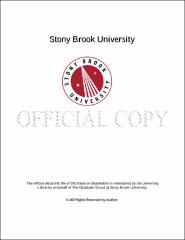| dc.identifier.uri | http://hdl.handle.net/11401/77065 | |
| dc.description.sponsorship | This work is sponsored by the Stony Brook University Graduate School in compliance with the requirements for completion of degree. | en_US |
| dc.format | Monograph | |
| dc.format.medium | Electronic Resource | en_US |
| dc.language.iso | en_US | |
| dc.publisher | The Graduate School, Stony Brook University: Stony Brook, NY. | |
| dc.type | Thesis | |
| dcterms.abstract | Methane (CH4) is the principle component of natural gas, and a controlled methane conversion pathway may influence chemical industry significantly. Nickel catalyst is a one of promising catalysts for methane activation, but suffering severe carbon deposition and degradation under reaction conditions. In this study, of the activation of CH4 in presence of water on nickel phosphide, Ni2P(0001), model surfaces were investigated, where the surface terminated by both Ni3P2 and Ni3P2+P were taken into considerations. Density functional theory (DFT) calculations were performed to determine structures and energetics of intermediates and transition states along the reaction pathways during CH4 activations. Compared to pure Ni, Ni2P promotes the water dissociation over CH4 dissociation significantly, which results in the formation of Nickel hydroxyphides or oxyphosphides. Among the systems studied, oxygen adsorbed at the Ni-P bridge site of Ni3P2-terminated Ni2P(0001) surface displays the highest activity toward C-H bond breaking and direct formation of methanol. Our results indicate that the formation of phosphides hinders the CO formation on pure Ni, while it opens a new route toward direct methane activation to methanol, an economical way to obtain valuable chemicals directly from abundant natural gas resources. It also hinders the surface poisoning, which is a big challenge for Ni catalysts. The unique catalytic behavior of Ni2P during methane reforming is associated with the synergy between Ni and P sites. | |
| dcterms.available | 2017-09-20T16:51:50Z | |
| dcterms.contributor | Wang, Jin | en_US |
| dcterms.contributor | Liu, Ping | en_US |
| dcterms.contributor | Simmerling, Carlos. | en_US |
| dcterms.creator | Zhang, Shuaifeng | |
| dcterms.dateAccepted | 2017-09-20T16:51:50Z | |
| dcterms.dateSubmitted | 2017-09-20T16:51:50Z | |
| dcterms.description | Department of Chemistry | en_US |
| dcterms.extent | 51 pg. | en_US |
| dcterms.format | Application/PDF | en_US |
| dcterms.format | Monograph | |
| dcterms.identifier | http://hdl.handle.net/11401/77065 | |
| dcterms.issued | 2017-05-01 | |
| dcterms.language | en_US | |
| dcterms.provenance | Made available in DSpace on 2017-09-20T16:51:50Z (GMT). No. of bitstreams: 1
Zhang_grad.sunysb_0771M_13275.pdf: 1631187 bytes, checksum: fe5a175de686a011500f970df4f2b416 (MD5)
Previous issue date: 1 | en |
| dcterms.publisher | The Graduate School, Stony Brook University: Stony Brook, NY. | |
| dcterms.subject | Chemistry | |
| dcterms.subject | catalyst, DFT, methane, methanol, Ni2P | |
| dcterms.title | Theoretical study of methane activation and methane-methanol conversion on Ni2P model catalysts | |
| dcterms.type | Thesis | |

